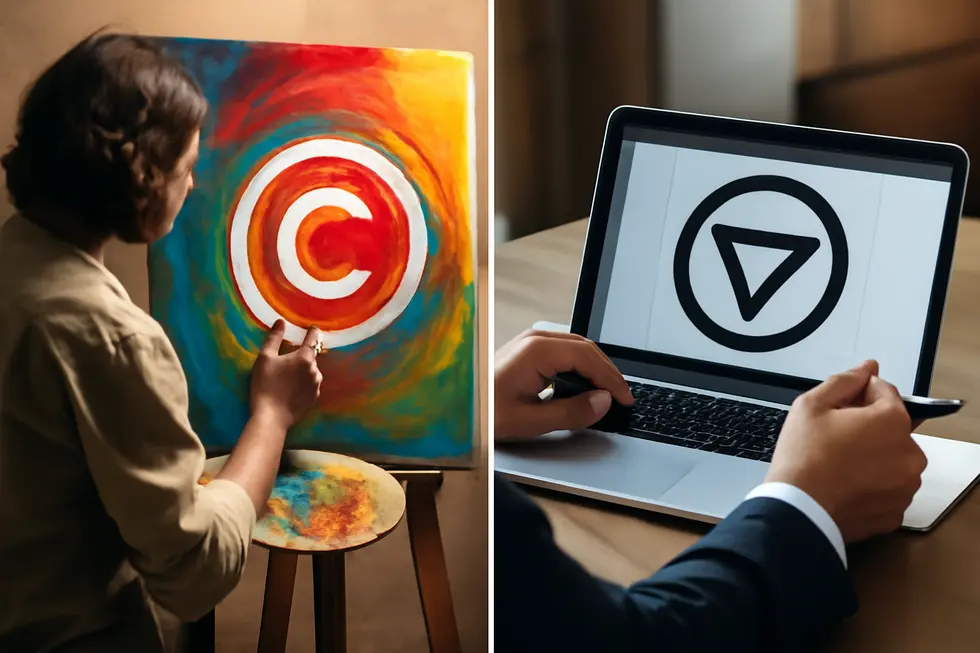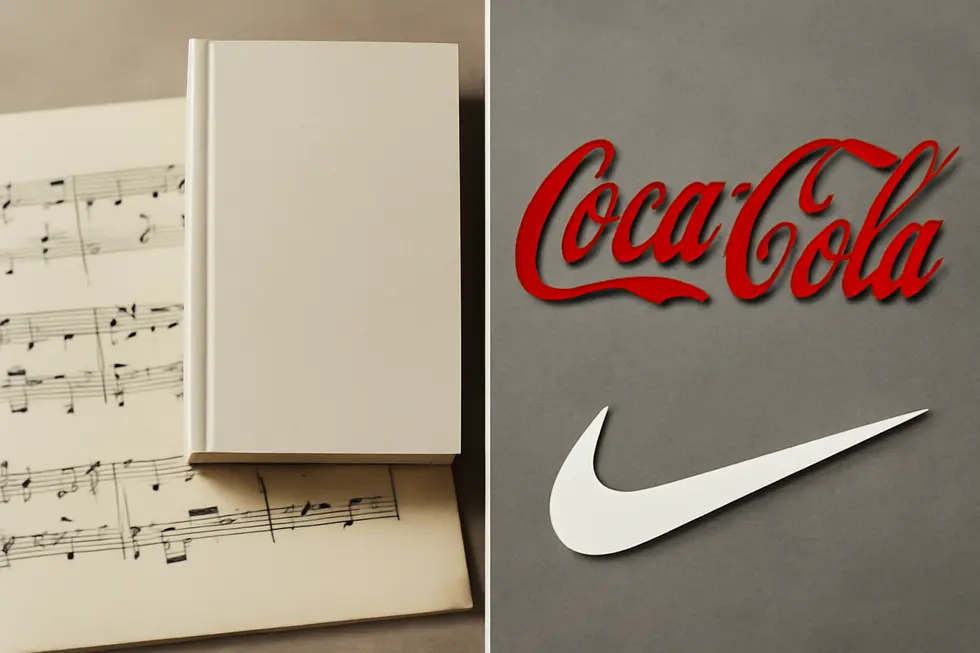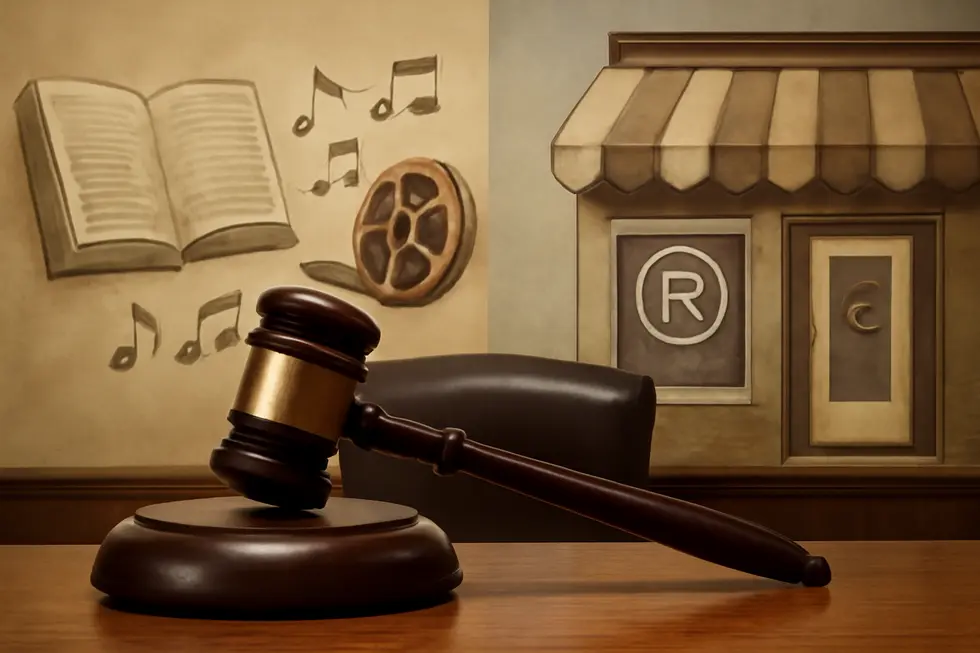Introduction
Protecting intellectual property is vital for business owners looking to safeguard their assets and maintain competitive advantage. Two primary forms of protection—copyright and trademark—serve different but complementary roles in securing creative works and brand identity. This guide breaks down their fundamental differences, backed by vivid examples, to clarify when and how each applies. You’ll learn not only what these protections cover but also their legal purposes, durations, and registration nuances. Additionally, we explore cases where copyright and trademark protections intersect, helping you build a robust IP strategy that preserves your company’s unique creations and brand presence. Each chapter brings clarity to these concepts, equipping you with actionable insights for your business’s intellectual property portfolio.
Tables of Contents
Chapter 1: Copyright vs Trademark Examples: Fundamental Differences and Definitions
- Navigating Technological and Legal Dimensions in Copyright and Trademark Protection
- Economic Impact and Brand Safeguarding: Navigating Copyright and Trademark Protections
- How Copyright and Trademark Shape Culture and Commerce Across Borders
Chapter 2: Key Examples Highlighting Copyright and Trademark Protection Differences
- Distinctive Protections: How Copyright and Trademark Safeguard Creativity and Brand Identity
- Balancing Innovation and Brand Identity: Economic and Technological Effects of Copyrights and Trademarks
- Navigating the Societal and Geopolitical Landscape of Copyright and Trademark Protections
Chapter 3: Copyright vs Trademark Examples: Purpose and Legal Intent Behind Protection
- How Creative Works and Brand Elements Illustrate the Distinction Between Copyright and Trademark Protection
- Intent and Impact: How Copyright and Trademark Laws Differ in Protecting Creativity and Commerce
- Evolving Durations and Intent: Navigating Protection and Good Faith in Copyright and Trademark Law
Chapter 4: Copyright vs Trademark Examples: Duration and Renewal Distinctions
- Navigating the Lifespan of Intellectual Property: Contrasting Duration and Renewal in Copyright and Trademark
- Navigating the Economic and Societal Effects of Duration and Renewal in Copyright and Trademark Protection
- Navigating the Lifespan of Protection: How Time and Territory Shape Copyright and Trademark Rights
Chapter 5: Navigating the Rights: Registration Processes and Legal Benefits in Copyright vs Trademark
- Decoding Registration: How Copyright and Trademark Protections Are Secured
- Distinct Legal Advantages and Enforcement Strategies in Copyright and Trademark Protection
- How Copyright and Trademark Protections Drive Creativity and Commerce
Chapter 6: Copyright vs Trademark Examples: Intersection and Overlap of Protections in Practice
- Dual Legal Shields: How Copyright and Trademark Together Secure Logos and Brand Identity
- When Artistic Expression Meets Brand Identity: The Dual Role of Copyright and Trademark in Packaging and Advertising
- Harnessing Copyright and Trademark Protections in Software and Digital Brands
Chapter 1: Copyright vs Trademark Examples: Fundamental Differences and Definitions

1. Navigating Technological and Legal Dimensions in Copyright and Trademark Protection
Copyright and trademark serve distinct but complementary roles in intellectual property law, each with unique technological and legal frameworks. Copyright safeguards original creative works such as books, music, films, software, and artwork by granting exclusive rights to reproduce, distribute, and adapt the expression fixed in a tangible medium. This protection is automatic upon creation, though registration enhances enforcement and potential damages recovery. In contrast, trademark protects distinctive brand identifiers—words, phrases, logos, or designs—that distinguish goods or services in commerce. Trademark rights typically require registration and ongoing use, defend against consumer confusion, and can last indefinitely with renewal. Technologically, copyright focuses on protecting creative content across various media formats, including digital and print, while trademark concentrates on brand elements, especially as used in commerce and digital branding. The legal scope differs as well: copyright protects the expression of ideas, whereas trademark protects the identity that signals origin to consumers. For those seeking deeper insights on trademark legal nuances, more detailed information is available on trademark protection for business names and logos. More comprehensive comparisons and examples can be found in authoritative resources like UpCounsel.
2. Economic Impact and Brand Safeguarding: Navigating Copyright and Trademark Protections
Copyright and trademark protections serve distinct economic and brand protection roles rooted in their legal purposes. Trademarks defend brand identifiers—such as names, logos, and slogans—that signal the source of goods or services and cultivate consumer trust. This protection enables businesses to build valuable brand loyalty and commercialize their identities via licensing and franchising, often enhancing company valuation with indefinite renewal potential. In contrast, copyright safeguards original creative works like music, literature, and software, granting creators exclusive rights to reproduce, distribute, and monetize their work, typically for the author’s life plus 70 years. While trademarks prevent market confusion by stopping unauthorized use of similar marks, copyright blocks unauthorized copying of artistic or literary expressions. These complementary protections bolster a company’s intangible assets in unique ways: trademarks secure market presence and consumer recognition, while copyrights protect creative economic interests. For a deeper understanding of trademark benefits in business, see this comprehensive resource on trademark protection for business name and logo. Externally, Wikipedia offers a detailed comparison among intellectual property types, highlighting their distinct economic roles.
3. How Copyright and Trademark Shape Culture and Commerce Across Borders
Copyright safeguards creators by protecting original works like literature, music, and art, encouraging innovation and cultural development. Its protection varies globally due to different legal traditions and treaties such as the Berne Convention, which harmonizes but does not unify enforcement or duration. This leads to complex licensing across borders, reflecting geopolitical priorities and societal values about access to knowledge versus creator rights. Ethical debates emerge over fair compensation, especially as digital distribution challenges traditional models.
In contrast, trademark law centers on commerce by protecting brand identifiers such as logos and slogans to maintain consumer trust and prevent confusion. Trademark laws differ internationally but emphasize continuous use and renewal for indefinite protection, supporting economic competition and market integrity. Together, copyright nurtures cultural expression while trademark sustains commercial identity, each influencing society and geopolitics in distinct yet complementary ways.
For more on protecting brand identity in business, see trademark protection for business names and logos.
(External reference: Berne Convention for the Protection of Literary and Artistic Works)
Chapter 2: Key Examples Highlighting Copyright and Trademark Protection Differences

1. Distinctive Protections: How Copyright and Trademark Safeguard Creativity and Brand Identity
Copyright secures original creative works such as books, music, movies, software, and visual art, granting creators exclusive rights to reproduce, distribute, perform, or display their work. For instance, the lyrics of a popular song from a major animated film are protected by copyright law, preventing unauthorized copying or adaptation. Trademark protects brand identifiers—words, logos, or slogans—that distinguish goods or services in commerce. A classic example is a globally recognized beverage company’s distinctive name and logo, safeguarded to maintain brand identity and avoid consumer confusion. Some assets, like logos, can receive both protections: copyright shields the artistic design itself, while trademark guards the logo’s use in the marketplace. Trademark protection relies on actual commercial use and can last indefinitely with renewals, whereas copyright protection extends for the life of the creator plus decades. Understanding these distinctions clarifies how intellectual property law simultaneously nurtures creative expression and defends brand value. For more on these legal differences, see trademark protection for business names and logos.
External resource: https://www.law.cornell.edu/wex/trademark
2. Balancing Innovation and Brand Identity: Economic and Technological Effects of Copyrights and Trademarks
Copyright secures original creative works such as literature, music, software, and art by granting exclusive rights to reproduce and distribute these expressions. In contrast, trademark protects names, logos, slogans, and designs that distinguish goods or services, ensuring brand recognition and consumer trust. Economically, copyright empowers creators to monetize their work, driving innovation and cultural growth. Trademarks, meanwhile, safeguard the commercial value of brands, enabling businesses to build and maintain market reputations over time, often indefinitely with proper use and renewal.
Technological advances pose unique challenges for both protections. The rise of digital media and AI-generated content complicates copyright enforcement due to questions of authorship and unauthorized replication. Simultaneously, online commerce heightens the importance of trademarks to prevent counterfeit goods and brand dilution in the digital marketplace. For example, a uniquely shaped product container might be copyrighted as an artistic design and trademarked as a symbol of origin, illustrating how these protections intersect.
This dynamic interplay highlights how copyright fosters creative expression while trademarks uphold commercial identity, reflecting their complementary roles in today’s evolving economic and technological landscape. For more details, explore trademark protection for business names and logos.
3. Navigating the Societal and Geopolitical Landscape of Copyright and Trademark Protections
Copyright secures original creative works like literature, music, and art, granting creators exclusive rights that enable control over reproduction and distribution. In contrast, trademark safeguards brand elements such as logos, names, and slogans that help consumers identify the source of goods or services. Beyond legal distinctions, these protections carry significant societal and geopolitical weight. Society strives to balance creators’ rights with public access and ethical use, especially in digital environments where sharing threatens traditional models. Geopolitically, intellectual property laws differ internationally, influenced by varied legal systems, cultural values, and trade policies. Treaties like the Berne Convention harmonize copyright protection but allow national differences that impact enforcement and licensing. Trademark protections hinge on jurisdictional registration, shaping multinational brand strategies. Together, copyright and trademark laws reflect how societies value creativity and commerce, navigating complex international frameworks that affect cultural exchange and global markets. For more on how trademarks protect your business identity, see trademark protection for business name and logo.
External detail: Berne Convention — https://www.wipo.int/treaties/en/ip/berne/
Chapter 3: Copyright vs Trademark Examples: Purpose and Legal Intent Behind Protection

1. How Creative Works and Brand Elements Illustrate the Distinction Between Copyright and Trademark Protection
Copyright shields original creative expressions such as books, music, films, software, and artwork by granting creators exclusive rights to reproduce, distribute, and display their works. Its legal intent centers on protecting the unique expression of ideas, ensuring creators retain control over their intellectual efforts and the value derived from them. For example, the lyrics to a popular song are safeguarded by copyright, preventing unauthorized copying or public performance.
In contrast, trademark protects brand identifiers like names, logos, slogans, or distinct designs that distinguish a company’s goods or services in the marketplace. This protection aims to prevent consumer confusion and unfair competition by preserving the integrity of a brand’s identity. Iconic elements such as a company’s logo or a product’s distinctive shape serve as trademarks, signaling to consumers the source behind the goods or services.
Together, these protections serve complementary purposes: copyright focuses on safeguarding creative content itself, while trademark secures the brand elements that communicate commercial origin and foster consumer trust. For a deeper view on how copyrights protect business content, see this detailed copyright information example for business.
External reference: U.S. Copyright Office, Copyright Basics.
2. Intent and Impact: How Copyright and Trademark Laws Differ in Protecting Creativity and Commerce
The legal intent distinguishing copyright from trademark protection lies in their fundamental objectives. Copyright safeguards original creative expression, granting authors exclusive rights automatically upon fixation in a tangible medium. This protection focuses on the expression itself, irrespective of any intent to confuse or profit unfairly. For example, an author’s novel is protected from unauthorized copying regardless of the copier’s motives. Conversely, trademark law centers on protecting brand identifiers—such as logos or names—that indicate the commercial source of goods or services. Here, intent is pivotal; courts carefully assess whether an alleged infringer acted in bad faith to mislead consumers or unfairly capitalize on brand goodwill. Bad faith use triggers stringent enforcement, while innocent or independent use may be treated more leniently. Thus, copyright shields the creative work itself, while trademark guards the identity behind it, emphasizing intent to prevent consumer confusion and maintain marketplace integrity. For more details on protecting business names and logos, see trademark protection for business name and logo. The nuances of intent in trademark enforcement underscore its unique role alongside copyright in intellectual property law.
3. Evolving Durations and Intent: Navigating Protection and Good Faith in Copyright and Trademark Law
Copyright and trademark protections serve different legal purposes, reflected sharply in their duration and enforcement focus. Copyright grants creators exclusive rights for a fixed period, typically the author’s life plus 70 years, after which the work enters the public domain. This term is automatic without renewal, ensuring long-term but finite protection over original creative works. In contrast, trademark rights can last indefinitely, provided the mark is actively used in commerce and renewal filings occur every ten years, reflecting the commercial importance of maintaining brand identity over time.
Enforcement further distinguishes these protections. Copyright infringement hinges less on intent and more on the unauthorized use of protected works. Trademark law, however, critically examines the intent behind use, emphasizing good faith—where a party honestly adopts a mark versus bad faith infringement designed to exploit another’s reputation. Demonstrating good faith in trademark adoption can mitigate penalties, encouraging businesses to document their processes carefully. Iconic trademarks, like recognizable logos, maintain their protection through continuous use and renewal rather than lifespan alone.
This contrast in duration and enforcement highlights copyright’s role in protecting creative expression over time, while trademarks safeguard ongoing commercial goodwill and identity. For businesses seeking to understand these dynamics deeply, exploring trademark good faith nuances is essential. More details on this subject are available through a detailed discussion on trademark enforcement intent.
Chapter 4: Copyright vs Trademark Examples: Duration and Renewal Distinctions

1. Navigating the Lifespan of Intellectual Property: Contrasting Duration and Renewal in Copyright and Trademark
Copyright safeguards original creative works such as novels, music, and artwork by protecting the expression of ideas. Its protection arises automatically upon creation and endures for the author’s lifetime plus 70 years in the U.S., with no option for renewal once this term expires. This finite duration ensures that creative works eventually enter the public domain. In contrast, trademark protection centers on brand identifiers like logos, names, and slogans that distinguish products or services. Trademark rights can last indefinitely, provided the mark remains in active use and is renewed, typically every 10 years in the U.S. Registration strengthens these rights, allowing use of the ® symbol, while unregistered marks may use TM. This ongoing renewal process highlights trademark’s role in continuously protecting commercial identity. Unlike copyright’s limited term, trademark protection is sustained by persistent use and timely renewal, reflecting their distinct legal and commercial purposes. For more on trademark protections and renewal, see trademark protection for business names and logos.
2. Navigating the Economic and Societal Effects of Duration and Renewal in Copyright and Trademark Protection
Copyright safeguards original creative works such as literature, music, and software by granting exclusive rights for the life of the author plus 70 years. This finite term fosters cultural enrichment by eventually contributing to the public domain, allowing broader access and further innovation. Although copyright protection is automatic upon creation, registration enhances legal enforcement, encouraging investment in creative industries. Its economic benefits often support intermediaries like publishers but ultimately drive societal progress through accessible cultural content.
In contrast, trademarks protect brand identifiers—including names, logos, and slogans—with potentially indefinite duration, provided timely renewals, typically every ten years. This continuous protection preserves brand reputation, reduces consumer confusion, and deters counterfeit goods, which sustains market confidence and competition. Unlike copyright, trademarks focus on maintaining commercial identity and trust over time.
Together, these protections shape the intellectual property landscape, balancing incentives for creativity and commerce. The perpetual nature of trademarks supports long-term brand equity, while copyright’s finite term nurtures a cycle of innovation and public benefit. For more on these distinctions, explore categories of intellectual property rights.
External resource for comprehensive insight: https://trademark2go.com/categories-intellectual-property-rights/
3. Navigating the Lifespan of Protection: How Time and Territory Shape Copyright and Trademark Rights
Copyright protection spans the life of the author plus 70 years, or for corporate works, up to 95 years from publication. This fixed term safeguards creative expressions like books, music, or software, but it inevitably expires, placing works into the public domain. In contrast, trademarks can endure indefinitely, provided they remain in active use and are properly renewed, usually every decade in the U.S. This ongoing protection preserves brand identity and prevents consumer confusion. Technological advancements have amplified these distinctions: copyright secures digital creations including software and multimedia, while trademarks protect brand markers such as logos and domain names in online marketplaces. Geopolitically, copyright terms vary across countries due to international treaties, affecting global distribution and licensing strategies. Trademark rights are territorial, requiring brand owners to navigate complex registration systems if they seek worldwide protection. This temporal and geographic interplay between copyright and trademark emphasizes their complementary roles in safeguarding creativity and commerce. For a comprehensive understanding of copyright duration and international factors, see this detailed guide on copyright duration and international considerations.
Chapter 5: Navigating the Rights: Registration Processes and Legal Benefits in Copyright vs Trademark

1. Decoding Registration: How Copyright and Trademark Protections Are Secured
Copyright protection automatically arises once an original creative work—like a painting, book, or song—is fixed in a tangible medium. No formal registration is required; however, registering with the U.S. Copyright Office provides enhanced legal benefits, such as eligibility for statutory damages if infringement occurs. This process is straightforward and voluntary but strategically important for enforcement. In contrast, trademark protection targets distinctive brand identifiers such as names, logos, or slogans which must be actively registered to gain robust legal rights. The registration involves submitting an application demonstrating the mark’s uniqueness and its use in commerce to authorities like the USPTO. Successfully registered trademarks benefit from indefinite protection, provided renewal and commercial use requirements are met. For example, the lyrics to “Let It Go” from Frozen gain copyright automatically, while the Coca-Cola® logo protects its brand identity as a trademark through registration. Understanding these distinct processes clarifies the complementary yet separate roles these protections serve in safeguarding creative expression and brand identity. For more insights on trademark protection, see trademark protection for business name and logo.
2. Distinct Legal Advantages and Enforcement Strategies in Copyright and Trademark Protection
Copyright safeguards original creative works fixed in a tangible form, granting creators exclusive rights to reproduce and adapt their works. This protection begins automatically upon creation, yet registering copyright strengthens enforcement in infringement suits, especially for unauthorized copying or distribution. Its protection typically lasts for the life of the author plus 70 years, ensuring long-term control over creative expression.
Trademark, on the other hand, defends brand identifiers—such as logos, slogans, and names—that distinguish goods or services in the marketplace. Trademark rights depend on use in commerce and are bolstered by federal registration, enabling owners to prevent confusingly similar marks and extend protection indefinitely through renewals. Enforcement focuses on stopping consumer confusion rather than copying.
While copyright restricts unauthorized exploitation of artistic content, trademark aims to preserve brand identity by preventing imitation. Their enforcement mechanisms differ: copyright infringement suits target unauthorized reproduction, whereas trademark actions address marketplace deception. This balance between guarding creative works and commercial symbols highlights their complementary roles in intellectual property law. For deeper insights, see trademark protection for business names and logos.
More details on copyright enforcement can be found at Cornell Law.
3. How Copyright and Trademark Protections Drive Creativity and Commerce
Copyright safeguards original creative works such as literature, music, films, software, and artwork, giving creators exclusive rights to reproduce and distribute their work. For example, song lyrics like those from “Let It Go” are protected under copyright, preventing unauthorized copying or sharing. On the other hand, trademark secures brand identifiers like names, logos, and slogans that distinguish products or services in the marketplace. The iconic Coca-Cola® logo is a trademark that maintains brand identity and prevents confusingly similar marks in commerce.
Economically, copyright fuels innovation in arts and technology by allowing authors and artists to monetize their creations over an extended duration—typically the creator’s life plus 70 years. Trademarks, which can last indefinitely with proper renewal, build lasting brand recognition and consumer trust, enhancing market value. Together, these protections support complementary economic roles: copyright encourages the production of creative content, while trademark underpins branding strategies and consumer decision-making.
For more detailed insights into protecting business names and logos, see trademark protection for business name and logo. For further legal explanations, refer to the Wikipedia trademark article.
Chapter 6: Copyright vs Trademark Examples: Intersection and Overlap of Protections in Practice

1. Dual Legal Shields: How Copyright and Trademark Together Secure Logos and Brand Identity
Logos often enjoy dual protection under copyright and trademark laws, each serving a unique but complementary role in safeguarding brand assets. Copyright shields the original artistic elements of a logo—the exact graphic design and creative expression—preventing unauthorized copying or reproduction of the artwork itself. However, it does not extend to simple names, slogans, or basic shapes alone. Trademark protection, on the other hand, covers those elements that identify and distinguish a brand commercially, including logos, names, slogans, distinctive fonts, and colors. This protection targets confusion in the marketplace, ensuring consumers can reliably identify the source of goods or services. For instance, a logo’s artistic design may be copyright-protected, while the same logo as a mark identifying the brand is protected by trademark law. This dual approach helps businesses maintain exclusive rights both over the creative work and its role in brand identity, providing stronger defense against misuse or infringement. For further guidance on comprehensive brand protection, see this resource on trademark protection for business names and logos.
2. When Artistic Expression Meets Brand Identity: The Dual Role of Copyright and Trademark in Packaging and Advertising
Copyright safeguards original artistic designs, text, images, and other creative elements on product packaging and advertisements. Meanwhile, trademark protects brand identifiers such as logos, brand names, slogans, and distinctive packaging features that signal the product’s source to consumers. This dual protection is crucial because packaging and ads commonly blend creative artwork with branding elements. For example, the unique graphic design on a package may be copyrighted, while the logo and overall package trade dress are trademarked to prevent confusingly similar uses by competitors. This overlap means companies can protect the same packaging both as a tangible piece of creative work and as a valuable brand symbol. Trade dress protection, a facet of trademark law, extends to the overall look and feel of packaging, guarding against unfair imitation. Advertising content like original photographs or copy is copyright protected, while slogans and logos within ads rely on trademark rights. This interplay reinforces comprehensive protection, ensuring both creative and commercial interests are secured. For a deeper look into trademark protection for brand names and logos, see trademark protection business name logo.
3. Harnessing Copyright and Trademark Protections in Software and Digital Brands
Copyright safeguards the creative expression found in software code, digital art, and written content, granting creators exclusive rights to copy and distribute these works. Trademark, on the other hand, protects the distinct brand identifiers such as software names, logos, and slogans that differentiate products or services in the marketplace. In software and digital environments, copyright shields the underlying code and creative design, while trademarks secure brand reputation and consumer recognition. For instance, software code is copyrighted to block unauthorized copying, whereas its name and logo receive trademark protection to prevent confusion about the software’s source. This dual protection extends to digital platforms where virtual goods and branded experiences rely on trademarks to enforce brand identity. Technologies like digital rights management (DRM) support copyright enforcement by restricting unauthorized access to software, highlighting tensions between protection and user rights. Emerging challenges include legal questions about AI-generated content and fair use in training datasets, reflecting the evolving landscape of intellectual property in digital realms. For more detailed guidance on brand protection, consult trademark protection for business names and logos. External insights on these complexities can be found at source.
Final thoughts
Understanding the distinctions and interplay between copyright and trademark protections is crucial for any business owner aiming to secure their intellectual property effectively. Copyright safeguards your original creative expressions—from books and music to software—giving you exclusive rights to reproduce and distribute these works. Meanwhile, trademark protection ensures your brand’s identity remains unique and distinguishable, preventing others from using confusingly similar marks that could dilute your brand’s value. Recognizing how these protections differ in purpose, duration, and registration processes empowers you to make informed decisions about protecting your business’s assets. Moreover, appreciating scenarios where both protections overlap enables a strategic approach that maximizes IP coverage. By actively managing your copyrights and trademarks, you can fortify your brand equity and creative endeavors, fostering long-term business growth and resilience.
Your IP is the foundation of your success – let’s protect it together before it’s too late. We can’t wait to help you turn your ideas into legally secured assets.
About us
undefined


